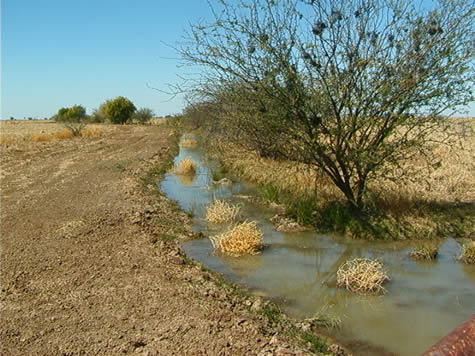2001 August 22, Wednesday. North Urandangi Road.
Without the Great Artesian Basin, much of inland Australia would be
uninhabitable. It has largely been taken for granted and exploited
since early European exploration penetrated the harsh interior of the
continent. For over a hundred years, huge amounts of water have been
pumped from the ground in the outback for stock and human use, and the
time is approaching when we should be thinking about working for the
preservation of this vital resource, before we are forced to.

There are about 4700 bores throughout the basin, 850 of which are
uncontrolled. 5 700 mega litres flow from bores each year, creating not
so much a problem with water drying out entirely, as with reduced
underground pressure. However in places, severe overuse has caused some
bores and mound springs to stop flowing altogether.
Initiatory effort is being made already to protect water supply for
future generations. Where in the early days of desert settlement, water
flow could be altered by a few turns of the bore head with a shifting
spanner; now supplies are regulated by a series of gauges and rows of
pumps, and are monitored by modern modems and computers.
Drainage channels, built across open land like moats, are being phased
out in favour of closed pipelines, as the resources to do so become
available. It is estimated that around ninety-five per cent of open
channel water is lost through a combination of evaporation, seepage,
and breakouts. On the other hand, local wildlife, which have come to depend
upon the sub ecosystem created by the channel supply, must relocate to
original sources, putting sudden and unsustainable pressure on those
reserves. "Cap and Pipe " programs have been instigated throughout the basin area
with differing levels of success. They aim to cap uncontrolled bores
and replace some of the 34 000 kilometres of exposed bore drains with piped
systems. The exposed channels of the old system can present dangers in
the form of disease spread through manure and decomposing carcasses,
and the spreading of weeds through seed transference. The tanks and troughs replacing the basins need to be checked regularly; water loss through blockages and seepage can be disastrous.

Consequently, each bore sunk in an isolated area becomes a huge community responsibility, and neighbours living many miles apart must work together to safeguard the water supply they rely upon so completely. An inordinate amount of organisation and work is required to bring the projects to success. Studies, site inspections, history and groundwater reports, geophysical logging, geological assessments, estimates of required work and resources, funding, and gaining support at public meetings are all required for each and every alteration to the
irrigation networks. Unforgiving environments, isolation, and logistics are all obstacles to the success of outback irrigation schemes. The high cost of permits for tapping the supply can be too much for many private landowners, who often run their properties on an overdraft, and are unable to produce that kind of money with the high input needed to keep their property running. The difference a reliable water source makes to cattle condition is profound, and is immediately recognisable both physically and in their behaviour.
With government support and collective effort, two hundred thousand mega litres should be able to be saved each year, as is aimed to be. Working toward the sustainability of this precious resource is so important, as it can mean life or death to the communities reliant upon it.
bel
Think of all the things you use water for each day. Imagine living away
from a clean water source - how long would you last? Think about the
reasons why open channels might have been used originally, instead of
pipelines. Why might settlers have begun such an inefficient method of
transferring the bore water across their land? What resources would
they have had available to them, both materially, and in knowledge of that
kind of engineering? Try to imagine attempting to bring water to an
inhospitable land with these resources. What does this tell you about
the tenacity and fortitude of the first settlers?